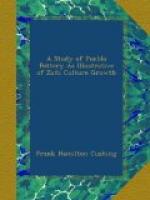A characteristic of these older forms of the water-jar is that they are invariably flat or round-bottomed, while more recent and all modern types of the olla (see Fig. 534) are concave or hollowed at the base (see Fig. 535) to facilitate balancing on the head. Outside of this concavity and entirely surrounding it (Fig. 536, a) is often to be observed an indentation (see Fig. 536, b) usually slight although sometimes pronounced.
[Illustration: FIG. 535.—Base of olla.]
[Illustration: FIG. 536.—Section of olla.]
[Illustration: FIG. 537.—Annular mat of wicker, or “milkmaid’s boss.”]
[Illustration: FIG. 538.—Use of annular mat illustrated.]
This has no use, but there is of course a reason for its occurrence which, if investigated, may throw light on the origin of the modern type of the olla itself. The older or round-bottomed jars were balanced on the head in carrying, by means of a wicker-work ring, a kind of “milk-maid’s boss.” (See Fig. 537.) These annular mats are still found among the ruins and cave-deposits, and continue in use with the modern Pueblos for supporting convex-bottom cooking pots on the floor as well as for facilitating the balancing of large food-bowls on the head. (See Fig. 538.) Obviously the latter dishes have never been hollowed as the ollas have been, because, since they were used as eating-bowls, the food could be removed from a plain bottom more easily than from a convex surface, which would result from the hollowing underneath. Supposing that a water-jar chanced to be modeled in one of the convex-bottom bread-baskets (see Fig. 539), it would become necessary, on account of the thickness of these wicker bowls, to remove the form from the mold before it dried. By absorption it would dry so rapidly that it would crack, especially in contracting against the convexity in the center of the basket-bottom. (See Fig. 539, a.) In order that this form might be supported in an upright position until dry, it would naturally be placed on one of the wicker-rings. Moreover, that the bottom might not sink down or fall out, a wad of some soft substance would be placed within the ring. (See Fig. 540, a.) As a consequence the weight of the plastic vessel would press the still soft bottom against the central wad, (Fig. 540, a) and the wicker ring (Fig. 540, c) sufficiently to cause the rounding upward of the cavity (Fig. 540, b) first made by the convex-bottom of the basket-mold, as well as form the encircling indentation (Fig. 540, c). Thus by accident, probably, only possibly by intention, was evolved the most useful and distinctive feature of the modern water-jar or olla, the concave bottom. This, once produced, would be held to be peculiarly convenient, dispensing with the use of a troublesome auxiliary. Its reproduction would present grave difficulties unless the bottom of the first vessel, thickly coated with sand to prevent cracking, was employed as a mold, instead of the absorbent convex-centered basket-bowl.




